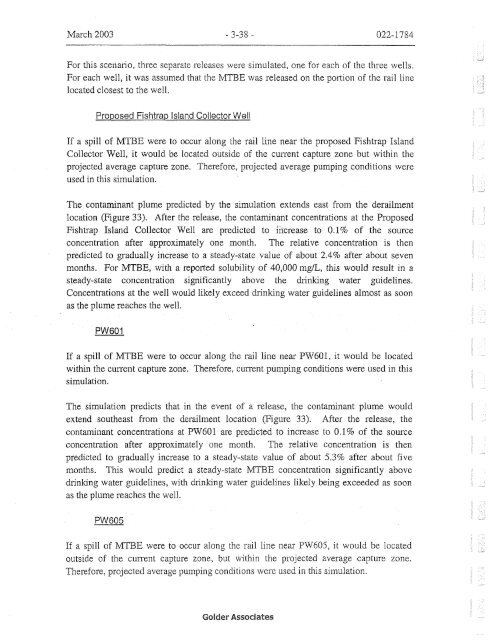CITY OF PRINCE GEORGE WELLS PROTECTION PLAN
Attch_February%2026%202016%20CPG%20wells%20protection%20report%20FINAL%20DRAFT%20V3
Attch_February%2026%202016%20CPG%20wells%20protection%20report%20FINAL%20DRAFT%20V3
You also want an ePaper? Increase the reach of your titles
YUMPU automatically turns print PDFs into web optimized ePapers that Google loves.
March 2003 022- 1784<br />
For this scenario, three separate releases were simulated, one for each of the three wells.<br />
For each well, it was assumed that the E was released on the portion of the rail line<br />
located closest to the well.<br />
If a spill of MTBE were to occur alo the rail line near the proposed Fishtrap Island<br />
Collector Well, it would be located ide of the current capture zone but within the<br />
projected average capture zone. Therefore, average pumping conditions were<br />
used in this simulation.<br />
The contaminant plume predicte<br />
xtmds east from the derailment<br />
location (Figure 33). After the rele<br />
nt concentrations at the Proposed<br />
Fishtrap Island Collector<br />
.I% of the source<br />
concentration after approx<br />
relative concentration is then<br />
predicted to gradually increase to a steady-state value o ut 2.4% after about seven<br />
BE, with a reporte<br />
, this would result in a<br />
steady-state concentration signifi g water guidelines.<br />
Concentrations at the well would lik<br />
king water guidelines almost as soon<br />
as the plume reaches the well.<br />
If a spill of MT E were to occur along the rai<br />
within the current capture zone.<br />
simulation.<br />
601, it would be located<br />
ditions were used in this<br />
The simulation predicts that in the event of a release, the contaminant plume would<br />
extend southeast from the derailment ocation (Figure 33). After the release, the<br />
contaminant concentrations at<br />
to increase to .I% of the source<br />
concentration after approximately one month. he dative concentration is then<br />
predicted to gradually increase t a steady-state value of about 5.3% after about five<br />
months. This would predict a steady-state E concentration significantly above<br />
drinking water guidelines, with drinking water guidelines likely being exceeded as soon<br />
as the plume reaches the well.<br />
If a spill of MTBE were to occur along the rail line near 60% it would be located<br />
outside of the current capture zone, but within the projected average capture zone.<br />
Therefore, projected average pumping conditions were used in this simulation.


